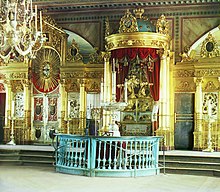Royal doors
This articleneeds additional citations forverification.(May 2011) |

Theroyal doors,holy doors,orbeautiful gatesare the central doors of theiconostasisin anEastern OrthodoxorEastern Catholicchurch.Thesanctuary(sometimes called theAltar,which contains theHoly Table) is separated from thenaveby a wooden screen called theiconostasis.The iconostasis represents Christian continuity from the veil of the Temple in Jerusalem which separated the people from theHoly of Holiesthat housed theArk of the Covenant.Normally, the iconostasis has three doors in it. The two single doors to the right and left are called "deacons' doors" or "angel doors" and they usually have on themiconsof either sainteddeacons(Saint Stephen,Saint Lawrence,etc.) or theArchangelsMichaelandGabriel.These are the doors that the clergy will normally use when entering the sanctuary. The central double doors are the "holy doors" (Slavonic:Svyatýa Vratá), which are considered to be most sacred, and may only be entered at certain sacred moments during the services, and only by ordained clergy (deacons, priests, bishops).

The termRoyal Doors(Greek:Ωραία Πύλη:Slavonic:Tsárskiya Vratá) is commonly used to describe the Holy Doors,[1]because Christ passes through these gates during theGreat Entranceat theDivine Liturgy(and most especially during theLiturgy of the Presanctified Gifts).[2]More properly, however, these doors should be called the "Beautiful Gate",[3]and in Greek this is the only term used, although the official English sites of theEcumenical Patriarchate,theOrthodox Church in Americaand theAntiochian Orthodox Churchall use the term "Royal Doors". In Russia, they are sometimes called the "Red Gates", red being synonymous with beautiful.

Whatever its name, a typical gate consists of two hinged doors. Often they will be only half-height, but sometimes they go almost all the way to the top of the opening. The doors themselves are made of wood or metal and usually have painted on them an icon of theAnnunciationin the form of adiptych(theTheotokoson the right door, and the Archangel Gabriel on the left), either alone or with thefour Evangelists.Other icons may be used also. The doors may be intricately carved and gilded, and are almost always topped by a cross.
Theologically the Holy Doors represent the gates ofJerusalem,through which Christ entered onPalm Sunday.They also represent the entrance to the Heavenly Jerusalem. In theRussian practice,there are detailed rules as to when the doors are to be opened duringVespers,Matins,and the Divine Liturgy. When the gates are opened, it represents moments when God is especially present to his people, such as during the reading of theGospel,or when the faithful are receivingHoly Communion.Most of the time the doors are closed. This is symbolic of penitence, a reminder that sin separates the individual from God.

There is also a curtain orveil,scored to remind that in theTemple in Jerusalem,behind the Holy Doors which is opened and closed at specific times during the services. While the veil is always open whenever the Holy Doors are opened, sometimes when the Holy Doors are closed, therubricscall for the veil to be opened. The curtain is usually more plainly decorated. Alternatively a sliding panel depicting "Christ the GreatHigh Priest"may take place of the doors and curtain and certain churches may have no physical barrier at all.[4]

Only the higher clergy (bishops,priests,and deacons) are permitted to go through the Holy Doors, and even they may only pass through them when it is prescribed by the liturgical rubrics.
DuringBright Week(the week following Easter Sunday), the Holy Doors and veil remain open the entire week. During this time, the open doors symbolize the openTombof Christ. TheEpitaphios(icon representing the burialshroudof Christ) is visible on top of the Holy Table (altar table) through the open Holy Doors as a witness of the Resurrection. During Bright Week, the clergy, who would normally use the Deacons Doors to go in and out of the sanctuary, will always enter and exit through the Holy Doors

When a bishop serves the Divine Liturgy, the Holy Doors and veil are left open for the entire service (except during the communion of the clergy). The bishop will always pass through the Holy Doors, even at times when priests or deacons cannot. If the rubrics call for the Holy Doors to be closed, they will be opened for him to pass through, and then immediately closed again.
In addition to referring to the Holy Doors, the termroyal doorscan also (and more properly) refer to either of the following:
- Most correctly, the termroyal doorsindicates the large central doors that separate thenarthexfrom the nave. This is the formal entrance to the church proper (i.e. the nave) and was, in former times, the ceremonial entrance of theEmperor,hence the epithet 'royal'. In current use, these doors are used by all although monasteries and some parish churches use the doors liturgically as the point where the abbot or a bishop vests before making a formal entrance.[3]
- A third use of "royal doors" is to indicate the outside entrance into the church.[citation needed]This appears to be a rare usage but appropriate to those churches that do not have a physical separation between the narthex and the nave.
References
[edit]- ^Peter Day,The Liturgical Dictionary of Eastern Christianity(Burnes & Oates, 1993,ISBN0-86012-216-6), p. 256.
- ^Archpriest Seraphim Slobodskoy,The Law of God(Holy Trinity Monastery, Jordanville, NY,ISBN0-88465-044-8), p. 532.
- ^abKen Parry, et al.,The Blackwell Dictionary of Eastern Christianity(Blackwell Publishers, 1999,ISBN0-631-18966-1), pp. 420–421.
- ^"Royal Doors - Questions & Answers".
